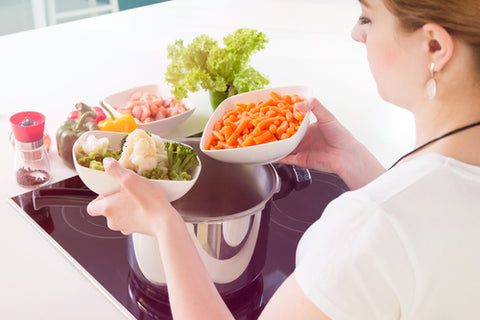Pressure cookers have become the hottest new way to cook one-pot dinners. The advent of new multi-cookers such as the Instant Pot is winning the hearts and stomachs of people all over the country. If you’ve recently gotten a pressure cooker or multi-cooker, then there are some tips and tricks that you should definitely know. After all, this is not your normal Crock-pot or slow cooker.

Pressure Cookers and Meats
The first thing you need to know about your new pressure cooker is that it’s not meant for all cuts of meat. When you’re pressure cooking your dinner, you want smaller even pieces. Use ribs or chops instead of roasts. The reason is that, with pressure cooking, all the heat is being pushed into the meat from the outside quickly. With a large roast or pork shoulder, you’re going to get uneven cooking with the outside being tough and chewy before the inside reaches safe temperatures. If you want a roast beef or pork shoulder for pork and sauerkraut, stick with a traditional slow cooker.
Secondly, don’t be afraid to use frozen meats when you’re using your pressure cooker. You may know that you should never use frozen meat in a slow cooker; that’s because a slow cooker leaves the meat at the danger temperature between 40 degrees Fahrenheit and 140 degrees Fahrenheit. That temperature is where bacteria bloom. Pressure cooking, on the other hand, cooks the meats in less than fifteen minutes in most cases. That means that any bacteria don’t have hours to grow.
Just keep in mind that when you do use frozen meats in your pressure cooker, use more liquid. Any frozen meat should be completely covered by the cooking broth, ensuring that the meat cooks quickly and evenly. You’re also going to need extra time for the frozen meat to cook. Most cook times will take an additional 50 percent time, so if your recipe normally calls for 10 minutes, cook it for 15. To be safe, make sure to use a good instant-read thermometer to ensure your food is cooked thoroughly.

Be Safe!
Many people see pressure cooker and have nightmares about exploding pots sending scalding water flying everywhere. Pressure cookers now are much safer, but there are still some basic safety rules that you should adhere to.
First and foremost is that you should never try to open the cooker while it’s under pressure. While most modern pressure cookers have safety measures in place that make it impossible to do so, you still should never try. If you need to open your cooker to add ingredients, turn it off and let the pressure subside.
The second safety rule is that cooking in a pressure cooker requires liquid. Make sure you read the manual that comes with your cooker to know how much you need to add. Additionally, ensure that you don’t overfill your cooker. In general, most pressure cookers have a maximum safe capacity of about 2/3 the total volume.
The last thing you should know to stay safe with your pressure cooker is what the different methods of depressurizing your cooker are. Most cookers have a quick release and a natural release method. Quick release for your pressure cooker usually involves pressing a pressure relief valve. This will cause a loud burst of steam that can be startling if you aren’t prepared. A natural release is when you just let the pressure cooker do its thing. As it sits, it will naturally bleed off pressure.
What type of depressurization you use will largely depend on what type of food you’re cooking. If you’re cooking a food that tends to foam, like dried beans, then you’ll want to use natural depressurization. On the other hand, if you have something that shouldn’t cook while you wait for the pressure to dissipate, use the quick release.

Everyday Cooking
There are a wide number of things that you can cook in a pressure cooker. With the popularity of pressure cooking on the rise, you can find recipes for everything from baked beans made in under an hour to cheesecake. Still, if you’re looking to create your own recipe, focus on dishes and things that are normally braized. Soups, stews, and risotto are all able to be cooked easily in a pressure cooker.
For a truly one-pot meal, you can layer your dishes in your cooker. For example, place potatoes on the bottom of your cooker in an inch of water as your base. Then add your steamer basket with a meatloaf inside. On top of the meatloaf, place a vegetable, such as green beans or corn, wrapped in foil. This meal actually only takes about 13 minutes to cook once your cooker is under pressure.

Maintenance
Taking care of your pressure cooker is simple. The cooking insert should remove for easy cleaning. Wipe the inside out with a damp cloth every once in a while. Wipe the outside with a damp sponge to keep it clean. Don’t immerse the unit, of course. It is an electric appliance.
One key thing that you should replace about every three months is the pressure seal. The rubber or silicone gasket is responsible for keeping the pressure in, and with regular use, it can absorb flavors and get a little funky. The gasket is easily replaced and ensures that your cooker will stay at pressure while you’re cooking.
Pressure cooking is an amazing time saver once you get the hang of it. You can make hard-cooked eggs in under five minutes, a pot of rice in three minutes, or brown and cook an entire chicken in under a half hour. With practice you can feed your entire family easily, taking food from freezer to table in under an hour. That gives you more time to spend with your family and friends instead of sweating over a hot stove.


